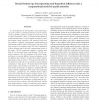Free Online Productivity Tools
i2Speak
i2Symbol
i2OCR
iTex2Img
iWeb2Print
iWeb2Shot
i2Type
iPdf2Split
iPdf2Merge
i2Bopomofo
i2Arabic
i2Style
i2Image
i2PDF
iLatex2Rtf
Sci2ools
CVPR
2007
IEEE
2007
IEEE
Beyond bottom-up: Incorporating task-dependent influences into a computational model of spatial attention
A critical function in both machine vision and biological vision systems is attentional selection of scene regions worthy of further analysis by higher-level processes such as object recognition. Here we present the first model of spatial attention that (1) can be applied to arbitrary static and dynamic image sequences with interactive tasks and (2) combines a general computational implementation of both bottom-up (BU) saliency and dynamic top-down (TD) task relevance; the claimed novelty lies in the combination of these elements and in the fully computational nature of the model. The BU component computes a saliency map from 12 low-level multi-scale visual features. The TD component computes a low-level signature of the entire image, and learns to associate different classes of signatures with the different gaze patterns recorded from human subjects performing a task of interest. We measured the ability of this model to predict the eye movements of people playing contemporary video g...
Bu Component | Bu Model | Computer Vision | CVPR 2007 | Td Component | Td Factors | Td Model |
| Added | 12 Oct 2009 |
| Updated | 12 Oct 2009 |
| Type | Conference |
| Year | 2007 |
| Where | CVPR |
| Authors | Robert J. Peters, Laurent Itti |
Comments (0)

